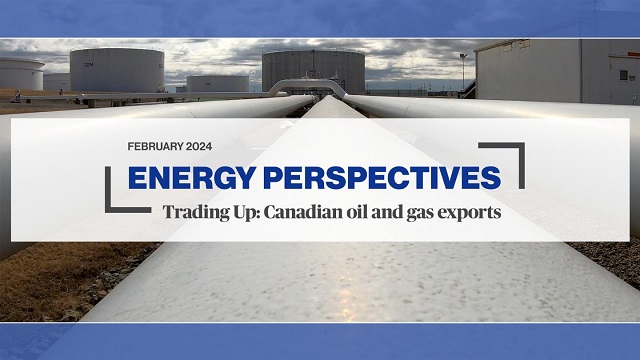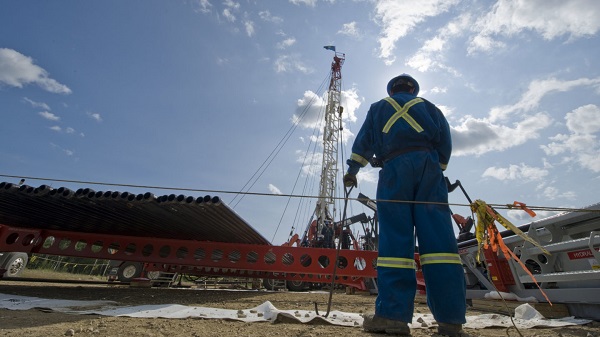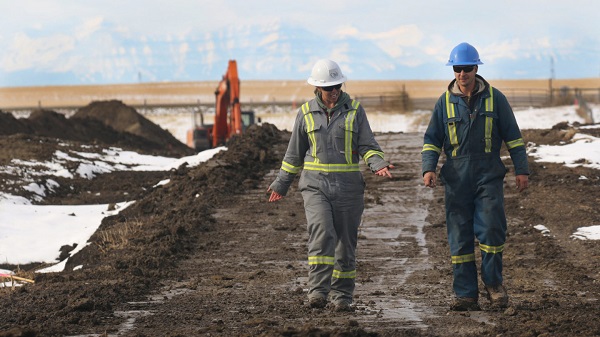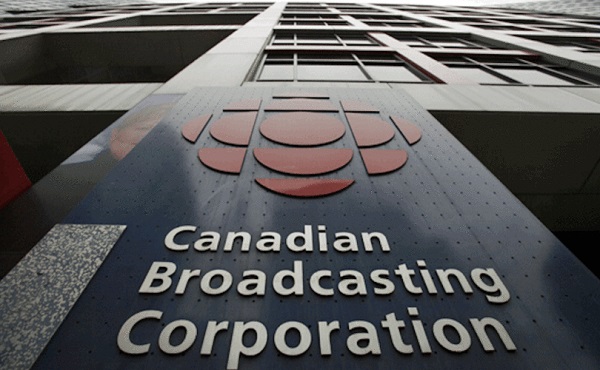Canadian Energy Centre
Energy Perspectives: Trading Up – Canadian oil and gas exports

From the Canadian Energy Centre
The composition of Canadian trade has changed significantly in the last 20 years, with oil and gas now Canada’s most significant export
Global trade patterns have changed in recent years due to ongoing political and economic turmoil. In Canada, these changes are apparent at all levels – provincial, national, and international. The share of goods and services exported has been exceptionally high since 2002 and stood at 33.7 per cent of GDP in 2022. In Canada, 1 in 6 jobs are linked to exports.
Exports have always been essential to Canada’s economy. In 2022, Canada exported $779 billion worth of goods and services, double the value from 2002. One main reason for the country’s substantial export numbers relates to soaring oil and gas prices. Oil and gas accounted for more than 50 per cent of the growth in Canada’s goods exports in 2022. Those numbers are part of a trend: in the last 20 years, from 2002 to 2022, oil and gas exports increased significantly, rising from $36.5 billion in 2002 to $182 billion in 2022, most of it going to the United States (see Figure 1).
Canada’s Top Five Exported Products, 2002 vs. 2022
Since 2002, the composition of Canada’s trade has shifted. In 2002, the top exported product was motor vehicle parts. That year Canada exported $61.1 billion worth of automotive parts, accounting for 16 per cent of total exports. Also, that year Canada’s oil and gas exports stood at $36.5 billion, or 9 per cent of exports (see Figure 2).
Since then, the share of automotive exports as a proportion of all Canada’s exports has declined, while the share of oil and gas exports has increased, mainly due to greater demand from the United States. In the last 20 years, on average, Canada exported $82 billion of oil and gas each year.
In 2022, Canada’s annual oil and gas exports reached a record $182 billion, and the sector accounted for 23 per cent of Canada’s total exports. Accompanying the increase in exports from the sector were increased prices for oil and gas, partly as a result of rising demand in the United States.
The Canadian Energy Centre’s “Energy Perspectives” are short analyses released periodically to provide context on energy issues for investors, policymakers, and the public. The source of profiled data depends on the specific issue.
Canadian Energy Centre
Ignoring the global picture and making Canadians poorer: Energy and economic leaders on Ottawa’s oil and gas emissions cap

From the Canadian Energy Centre
The federal government’s draft rules to cap emissions – and by credible analysis, production – from Canada’s oil and gas sector will make Canadians poorer, won’t reduce world emissions, and are a “slap in the face” to Indigenous communities.
That’s the view of several leaders in energy and the economy calling out the negative consequences of Ottawa’s new regulations, which were announced on November 4.
Here’s a selection of what they have to say.
Goldy Hyder, CEO, Business Council of Canada
“At a time when Canada’s economy is stalling, imposing an oil and gas emissions cap will only make Canadians poorer. Strong climate action requires a strong economy. This cap will leave us with neither.”
Deborah Yedlin, CEO, Calgary Chamber of Commerce
“Canada would stand as the only country in the world to move forward with a self-imposed emissions cap.
“Given that our economic growth numbers have been underwhelming–and our per-person productivity lags that of the United States by $20,000, one would expect the government to be more focused on supporting sectors that are critical to economic growth rather than passing legislation that will compromise investment and hamper our growth prospects.
“…If the Canadian government wants to reduce emissions, it should follow the private sector’s lead – and strong track record – and withdraw the emissions cap.”
Stephen Buffalo, CEO, Indian Resources Council of Canada
“Over the past four decades, Canadian governments urged and promoted Indigenous peoples to engage in the natural resource economy. We were anxious to break our dependence on government and, even more, to exercise our treaty and Indigenous rights to build our own economies. We jumped in with far more enthusiasm and commitment than most Canadians appreciate.
“And now, in a bid to make Canada look ecologically virtuous on the world stage, the Liberal government imposed further restrictions on the oil and gas sector. This is happening as Indigenous engagement, employment and equity investment are growing and at a time when our communities have had their first taste of real and sustainable prosperity since the newcomers killed off all the buffalo. Thanks for nothing.”
Trevor Tombe, professor of economics, University of Calgary School of Public Policy
“[The emissions cap] is a wedge issue that’s going to be especially popular in Quebec. And I don’t think the [federal government’s] thinking goes much further than that.”
Kendall Dilling, president, Pathways Alliance
“A decrease in Canadian production has no impact on global demand – meaning another country’s oil will simply fill the void and the intended impact of the emissions cap is negated at a global level.
“An emissions cap gives industry less – not more – of the certainty needed to make long-term investments that create jobs, economic growth and tax revenues for all levels of government. It simply makes Canada less competitive.”
Michael Belenkie, CEO, Advantage Energy
“Canada’s emissions profile is not unusual. What’s unusual about Canada and our emissions is we seem to be the only exporting nation of the world that is willing to self-immolate. All we’re doing is we’re shutting ourselves down at our own expense and watching global emissions increase.”
Kevin Krausert, CEO and co-founder, Avatar Innovations
“The emissions cap risks delaying – if not derailing – a whole suite of emissions-reduction technology projects. The reason is simple: it has added yet another layer of uncertainty and complexity on already skinny investment decisions by weakening the most effective mechanism Canada has in place.
“…After nearly 15 years of experimenting in a complicated regulatory system, we’ve finally landed on one of the most globally effective and fungible carbon markets in the world in Alberta, called TIER.
“What the federal emissions cap has done is introduce uncertainty about the future of TIER. That’s because the cap has its own newly created cap-and-trade system. It takes TIER’s 15 years of experience and market knowledge and either duplicates functioning markets or creates a whole new market that may take another 15 years to get right.”
Dennis Darby, CEO, Canadian Manufacturers & Exporters
“The federal government’s announcement of a cap and trade on oil and gas emissions threatens Canada’s energy trade, economic interests, and national unity.”
Adam Legge, president, Business Council of Alberta
“The oil and gas emissions cap is a discriminatory and divisive policy proposal—the epitome of bad public policy. It will likely cap Canadian prosperity—billions of dollars and tens of thousands of jobs lost for no benefit, and the burden will be borne largely in one region and one sector.”
Lisa Baiton, CEO, Canadian Association of Petroleum Producers
“The result would be lower production, lower exports, fewer jobs, lower GDP and lower revenues to governments to fund critical infrastructure and social programs on which Canadians rely.”
Statement, Canadian Association of Energy Contractors
“The Trudeau government does not care about Canadian blue-collar, middle-class energy workers who rely on the industry to support their families. It does not care about small, medium and Indigenous energy service businesses that operate in rural and remote communities across Western Canada. And it certainly does not care about supporting our allies who are desperate for oil and gas from sources other than regimes such as Russia or Iran.”
Peter Tertzakian, executive director, ARC Energy Research Institute
“Focusing on a single sector while ignoring others is problematic because each tonne of emissions has the same impact on climate change, regardless of its source. It makes little sense to impose potentially higher economic burdens on one economic sector when you could reduce emissions elsewhere at a lower cost.”
Shannon Joseph, chair, Energy for a Secure Future
“Canada continues to pursue its climate policy in a vacuum, ignoring the big picture of global emissions. This places at risk our international interests, tens of thousands of good paying jobs and important progress on reconciliation.”
Adam Sweet, director for Western Canada, Clean Prosperity
“Layering on a new cap-and-trade system for oil and gas producers adds uncertainty and regulatory complexity that risks undermining investment in emissions reductions just as we’re getting close to landing significant new decarbonization projects here in Alberta.”
Alberta
For second year in a row, Alberta oil and gas companies spend more than required on cleanup

From the Canadian Energy Center
By Grady Semmens$923 million spent cleaning up inactive wells, sites and pipelines in 2023
As a business owner, Ryan Smith values few things more than predictability when it comes to the oil and gas market and the demand for his company’s services.
That’s why knowing that next year in Alberta, the regulator requires at least $750 million worth of work cleaning up inactive oil and gas wells and other legacy energy infrastructure is tremendously helpful for the CEO of Calgary-based 360 Engineering & Environmental Consulting.
“Having a minimum spend in place for the province makes the market more predictable and consistent, which in turn helps our clients and our business plan for the future, which is a good thing,” says Smith, whose company has completed more than 5,000 site closure activities in Canada and internationally since 2015.
“Site closure has really emerged as a growth market over the last decade, especially in Western Canada where the regulatory systems for oil and gas are more advanced than anywhere else we are exposed to. It is an integral part of the energy lifecycle, and if it is done well it adds a lot of value to the industry.”
The Alberta Energy Regulator (AER) introduced an industry-wide minimum “closure” spending requirement in 2022, part of Alberta’s Inventory Reduction Program to accelerate the remediation of inactive oil and gas wells, facilities and pipelines across the province.
The mandatory quota determines the minimum level of work a company must conduct primarily to decommission and reclaim a proportion of its inactive inventory.
Inactive wells are defined as those that have not been used for six months or a year, depending on what they are being used for. When a company decides that they will not reactivate an inactive well they decommission it through a process called abandonment.
A well is considered successfully abandoned after it is cleaned, plugged with cement, cut to a minimum of one meter below the surface and covered with a vented cap. After abandonment comes remediation and reclamation, where the land around the well is returned to the equivalent of its original state.
The first two years under the new rules saw Alberta’s energy industry significantly exceed the minimum closure requirements.
In 2022, companies spent more than $696 million, about 65 per cent more than the initial threshold of $422 million. The AER increased the minimum spend to $700 million in 2023, which producers surpassed by 22 per cent with total expenditures of $923 million.
The 2024 minimum remains at $700 million, while in July the regulator announced that the minimum spend for 2025 was raised to $750 million.
This closure work does not include remediation of oil sands mining sites, which is handled under the Mine Financial Security Program, nor does it include the closure of orphan wells (wells without a legal owner) managed by the industry-funded Orphan Well Association.
Gurpreet Lail, CEO of Enserva, an industry association representing energy service companies, suppliers and manufacturers, says there was an initial rush of closure work when the quotas were first put in place, but activity has since become more even as companies develop long-term closure plans.
“A lot of the low-lying fruit has been taken care of, so now companies are working on more complex closure files that take more time and more money,” Lail says.
Facility owners say that Alberta’s rules provide direction for planning closure and remediation work, which in the past may have been put on hold due to the ups and downs of the oil and gas market.
“When commodity prices are up, everyone is focused on drilling more wells and when prices are down, budgets are strained for doing work that doesn’t bring in revenue. Having a minimum spend makes sure closure work happens every year and ensures there is longer-term progress,” says Deborah Borthwick, asset retirement coordinator for Birchcliff Energy, an oil and natural gas producer focused in Alberta.
Over the last few years, Birchcliff has budgeted more than $3 million for annual facility closure work, far above its required minimum spend.
The company completed 11 well abandonments and decommissioned 23 facilities and pipelines in 2022, according to its latest environmental, social and governance report.
Borthwick says having the closure quota for 2025 already set has allowed it to plan ahead and line up the necessary service companies well in advance for next year’s remediation work.
-

 ESG2 days ago
ESG2 days agoCan’t afford Rent? Groceries for your kids? Trudeau says suck it up and pay the tax!
-

 John Stossel2 days ago
John Stossel2 days agoGreen Energy Needs Minerals, Yet America Blocks New Mines
-

 Daily Caller2 days ago
Daily Caller2 days agoLos Angeles Passes ‘Sanctuary City’ Ordinance In Wake Of Trump’s Deportation Plan
-

 Alberta2 days ago
Alberta2 days agoProvince considering new Red Deer River reservoir east of Red Deer
-

 Addictions2 days ago
Addictions2 days agoBC Addictions Expert Questions Ties Between Safer Supply Advocates and For-Profit Companies
-

 Aristotle Foundation1 day ago
Aristotle Foundation1 day agoToronto cancels history, again: The irony and injustice of renaming Yonge-Dundas Square to Sankofa Square
-

 armed forces1 day ago
armed forces1 day agoJudge dismisses Canadian military personnel’s lawsuit against COVID shot mandate
-

 Business17 hours ago
Business17 hours agoCBC’s business model is trapped in a very dark place







